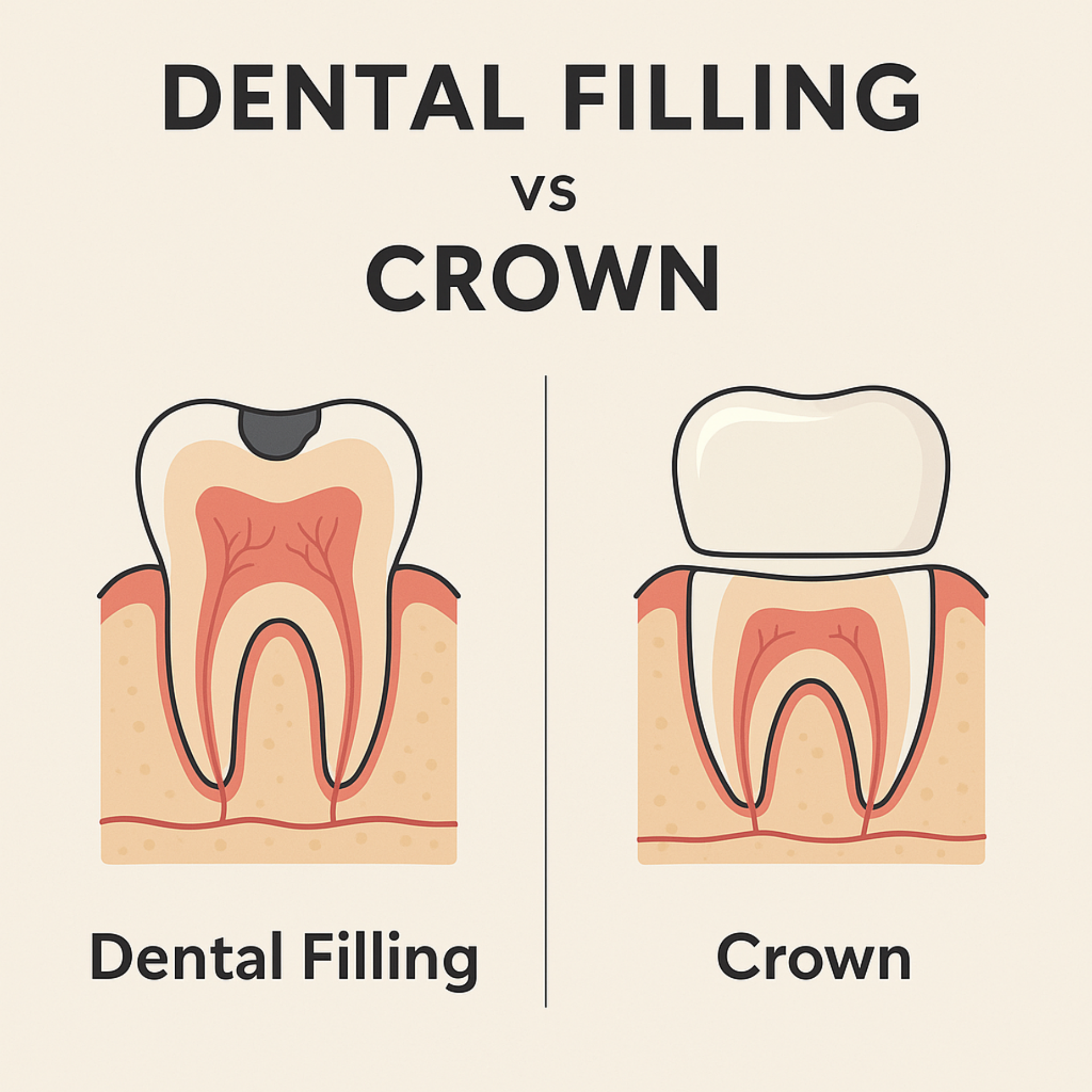There are significant differences between a filling and a crown, but they serve the same purpose: to restore a damaged or decayed tooth. When a dentist recommends one instead of the other, it’s important to understand why. The decision depends on the severity of the cavity and condition of the tooth, and which treatment option is best for your dental health.

What Are
Dental Fillings?
When a tooth has a cavity, it’s because bacteria has eaten away at the protective enamel and penetrated the tooth’s surface, forming a hole. The goal of a filling is to fill that hole and stop bacteria from spreading further into the tooth. Fillings can be made of porcelain, composite resin, silver amalgam, or gold.
If a cavity is found before it has a chance to grow very big, fillings are a very effective solution to restore the tooth. With proper care, most fillings have a life of up to 15 years or longe
What Are Dental Crowns?
Dental crowns are also called dental caps, because they go on top of the tooth. Their purpose is to seal bacteria out of the tooth. They are usually necessary if the tooth has extensive decay or damage, or already has a filling in it from a previous cavity.
Crowns are made from ceramic, porcelain fused to metal, resin, or gold. To make a crown, a dentist takes an impression of the patient’s teeth and then creates a cap that looks and feels like the natural tooth.
When placing a crown, any decay or old fillings are first removed. Then the dentist fills the empty space with a composite material and places a temporary crown over it while the permanent, more natural looking tooth is being made. The patient must come back for a second appointment so the dentist can replace the temporary crown with the permanent crown, sealing it into place.
Like fillings, crowns last up to 15 years.
Crown vs. Filling: Which Option is Best?
For patients wondering if crowns are better than fillings, the answer is not necessarily. The average cost of a crown is $800 to $1800, whereas a filling will cost between $100 and $250. Any reputable dentist will not choose to do the more lengthy and more expensive procedure if it’s not necessary. Instead, they will choose the treatment option that best restores the tooth and prevents further damage.
Here are some things that dentists consider when deciding which route to take:
Location
Front teeth require less drilling due to having a single root. They are also not responsible for heavy chewing like molars. A front tooth could potentially have enough strength and stability with just a filling.
Cavity Size
If a cavity is in its early stages, it can probably be repaired with a filling. A visual exam or X-ray can tell the dentist how deep the hole is to verify whether a filling will work.
But if the dentist sees that a cavity is taking up a large part of the tooth or that there is another filling already in it, he or she will usually suggest a crown since there may be no more space to fill it.
Tooth Condition
Filling a cavity in a tooth that has already been filled can cause the tooth to become weak, making it unable to support normal biting and chewing. This can allow the tooth to crack or break while also causing stress and pain on surrounding teeth. A crown is made of strong material that supports the tooth and makes chewing easier.
A tooth full of fillings can also put the patient at risk for pulpitis, an infection of the tooth’s pulp that can affect nerves and blood vessels and eventually cause the tooth to die. It’s better to place a crown over a tooth with extensive decay to prevent this from happening.
And finally, if a tooth is already chipped, cracked or broken, bacteria can easily get in and cause decay. Rather than wait for a cavity to form, dentists can take a proactive approach and cap the tooth — sealing out bacteria and restoring the patient’s smile.
Extent of Decay
If pulpitis already exists in the tooth, a filling is not an option. A root canal will be necessary to remove the infected tissue and save the tooth. Treatment involves hollowing out and cleaning the inner core of the tooth, filling it with a composite material, and then capping it off with a crown to seal and stabilize the tooth.

Does Getting a Crown Hurt More Than a Filling?
With today’s dental anesthesia options, neither fillings or dental crowns are painful. Most procedures can be done under local anesthesia to simply numb the area. However, if a patient has dental anxiety or special needs, sedation may be administered via nitrous oxide (laughing gas), pills, or IV.
Pain in The Filling Procedure
Prior to a dental filling, the dentist will numb the area by applying a shot of anesthetic (Novocain, for example) to your gums just below the tooth. The shot itself might feel like a pin-prick or pinch. Some dentists also apply a topical anesthetic to numb the gums before the shot.
Once the area is numb, the dentist will “drill out” the tooth to grind away the decayed parts. While the process can be loud and create pressure or vibration, it shouldn’t hurt. After the decay is removed, the dentist will clean the area and then fill the cavity space with the chosen material, then shape and polish the tooth so it matches the consistency of the rest of the teeth. When the anesthetic wears off within about 2 hours, there should be no further pain.
Pain in The Crown Procedure
If a tooth is badly decayed, damaged or cracked, it may need to be filed down and filled before it can support a crown. This would require the same type of numbing as we explained above.
Taking an impression of the tooth does not cause pain. While waiting around two weeks for the permanent crown to be made, a temporary crown will be placed on top of the tooth. The placement itself shouldn’t be painful, but can cause pressure on the tooth and irritation to surrounding gums. Food particles can also get stuck under the temporary crown which can cause pain. Over the counter medicines such as ibuprofen can relieve it.
When the final dental crown is ready, local anesthetic may be used to fit and cement the crown to the tooth. Most patients say they feel no pain throughout the process. However, it’s common for gums to be sore after the placement for a few days.
Deciding on a Crown vs. a Filling
The difference between a filling and a crown is that they treat different dental issues. A huge cavity or broken tooth is an obvious candidate for a crown, while a small cavity can easily be addressed by a filling.
If you have pain in your tooth or have been told you have a cavity after an exam, it’s important to see a dentist to discuss the best treatment option. To find a dentist in your area, use our online search tool.


